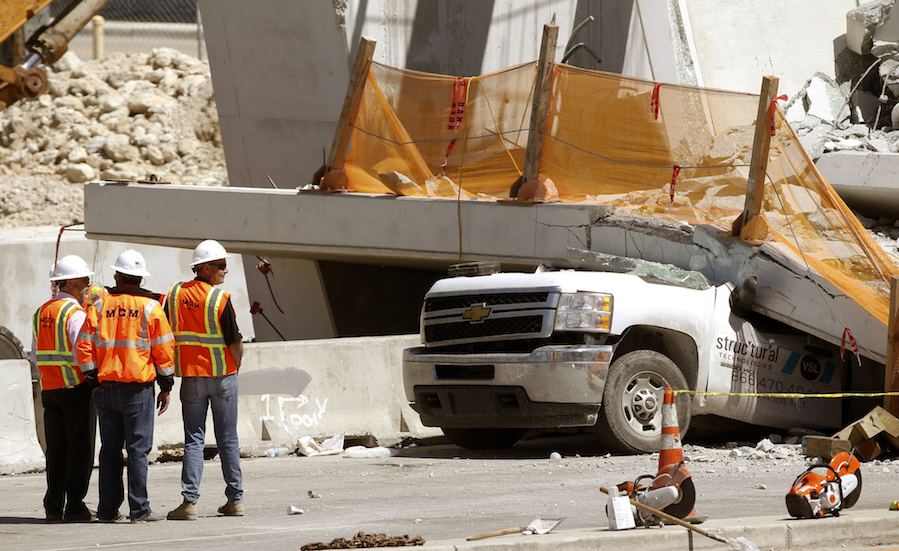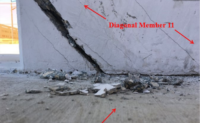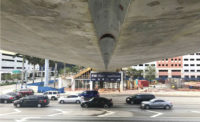Each day brings another detail about how what was intended to be a charming, $14-million pedestrian bridge at Florida International University near Miami took only seconds to become a national tragedy.
The partly completed structure’s sudden, catastrophic collapse at 1:47 p.m. on March 15 killed five motorists and one project worker. Robert L. Sumwalt, chairman of the National Transportation Safety Board, which is conducting one of several investigations, said the design-build contractor’s handling of risks—including those associated with continuing construction over live traffic—will be a focus of the agency’s safety investigation.
“We want to look at how the contractor identified the risk associated with what they were doing, and how they planned to mitigate those risks,” said Sumwalt. “That question will be key to this investigation.”
 |
| Debris and remaining structure at one end of the collapsed bridge at Florida International University. |
Among the questions will likely be whether the cracks that appeared at the north end of the bridge, where some observers believe the failure started, should have triggered a more urgent probe and precautions including closing or limiting traffic on the street below.
Instead, traffic flowed through normally as crews performed an adjustment above. Robert Accetta, investigator with NTSB, noted that, at the time of the collapse, crews were working one of the diagonal members at the north end of the structure “applying post-tensioning force that is designed to strengthen the diagonal member.”
 |
| A rendering of the Florida International University pedestrian bridge that appeared in the design-build contractor's proposal. |
The cable-stayed bridge had a 32-ft wide, 950-ton main span that had been swung into place using the Accelerated Bridge Construction method just five days earlier.
The bridge’s heart was a central, open truss, whose narrower top flange was a canopy over the wider bottom flange, which served as a walking surface. Cables from a 109-ft-high central pylon, which had not yet been built, were to have added stability. According to the proposal to FIU from the design-build team of Munilla Construction Management (MCM), South Miami, and FIGG Bridge Design, Tallahassee, the concrete deck was to have two-way post-tensioning tendons. The concrete truss members and canopy was to have been compressed with high strength steel cable and bars.
“It's not something that we've encountered before,” NTSB's Accetta said. “It's not uncommon in other bridge structures for them to put members under tension to strengthen them. It's not an unusual structure, but we do need to find out why and what may have caused the failure mechanism.”
 |
| A partial elevation is shown from design drawings for the bridge stamped by the engineer-of-record. |
The day after the collapse, the Florida Dept. of Transportation released the transcript of a voicemail it received from FIGG’s Denney Pate, the project’s lead engineer, describing cracking on the bridge’s north end. Pate said in the transcript that his company had "taken a look at it” and “obviously some repairs or whatever will have to be done but from a safety perspective we don’t see that there’s any issue there so we’re not concerned about it from that perspective although obviously the cracking is not good and something’s going to have to be” repaired.
While NTSB and other officials noted that cracking in a concrete structure doesn’t necessarily indicate significant structural issues—and may not have been a cause of the collapse—the issue was apparently significant enough that the project team met for more than two hours to discuss the topic, FIU reported in a March 17t statement.
At 9 a.m. on the morning of the accident, “The design-build team of MCM and FIGG convened a meeting at the MCM trailer … to discuss a crack that appeared on the structure. The FIGG engineer of record delivered a technical presentation regarding the crack and concluded that there were no safety concerns and the crack did not compromise the structural integrity of the bridge.”
________________________________________________
Lawsuit Claims Post-Tensioning Triggered Bridge Failure
Theories Outrun Reliable Facts in Florida Bridge Collapse
NTSB Joins Probe of Fatal Florida Bridge Collapse
________________________________________________
FIU noted that FDOT representatives were present. Later, FIU President Mark Rosenberg told the Miami Herald: “We’ve had a good relationship with FDOT — I just want to make it clear. So we’re anxious to find out more about what they think we didn’t do. Because they’ve been involved at every step.”
A statement from FIGG Bridge Engineers noted: “We are heartbroken by the loss of life and injuries, and are carefully examining the steps that our team has taken in the interest of our overarching concern for public safety. The evaluation was based on the best available information at that time and indicated that there were no safety issues.”
Among the victims was an FIU student, Alexa Duran, 18, and an employee of one of the project subcontractors, Navaro Brown, 37. The other victims were Rolando Fraga Hernandez, 60; Osvaldo Gonzalez, 57; Alberto Arias, 54, and Brandon Brownfield, whose age was not given.






Post a comment to this article
Report Abusive Comment